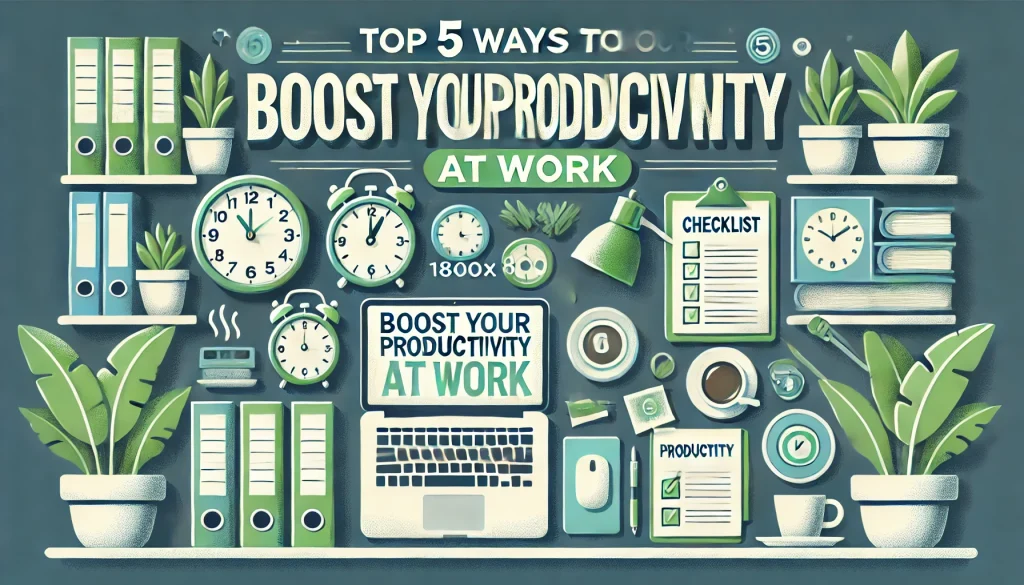
A Complete Guide to Mastering Productivity In the fast-paced world of today, success on both a personal and professional level depends on mastering productivity. This article explores a number of tactics that can help people become more productive, with an emphasis on establishing specific objectives and priorities, using technology & tools efficiently, reducing distractions, taking regular breaks, and managing time effectively. The foundation of efficient productivity is the establishment of specific goals.
People who clearly state their goals establish a road map that directs their choices and actions. People can concentrate their efforts on the things that really matter when they have clear goals because they give them direction and purpose. For example, “I will exercise for 30 minutes five times a week” is a more specific goal than “I want to be healthier,” which is inherently vague.
This level of detail not only clarifies the intended result but also facilitates progress monitoring. It’s also crucial to prioritize these objectives. People can better manage their time & resources by determining which objectives are most important, ensuring that they are working on projects that support their long-term objectives. Setting clear objectives and reviewing them frequently are essential, as is making any necessary adjustments.
Because life is dynamic and situations can change quickly, it is essential to set goals with flexibility. It is possible to identify any changes in priorities or potential new opportunities by routinely evaluating one’s goals. In addition to keeping people on track with their overall goals, this practice helps them feel accomplished when they reach milestones along the way. Through the combination of well-defined objectives and continuous assessment, people can sustain a productive path that adjusts to their changing requirements & desires. Increasing Productivity through Time Management That Works. Productivity can be greatly increased by having good time management skills.
The Pomodoro Technique is one well-liked method that divides work into 25-minute blocks and intersperses them with brief breaks. This approach makes use of the theory that a timer instills a sense of urgency, motivating people to concentrate particularly hard during work periods. Structured breaks can help prevent burnout. A longer break is taken after finishing a series of intervals to allow for mental renewal.
By ensuring that people take regular breaks to refuel, this methodical approach not only aids in sustaining focus but also helps to avoid burnout. Task Prioritization Using the Eisenhower Matrix. Using the Eisenhower Matrix, which groups tasks according to their importance and urgency, is another efficient time management technique. People can better prioritize their workload by grouping tasks into four quadrants: urgent and important, important but not urgent, urgent but not important, and neither urgent nor important. This approach minimizes time spent on less important activities while encouraging people to concentrate on high-impact activities that make a substantial contribution to their goals.
Increasing Productivity through Time Management Strategies. Making the most of every day and increasing productivity are possible for people who use these time management strategies. In this day and age, reducing distractions is essential to sustaining productivity. Establishing a focused, distraction-free workspace is one useful tactic. Finding a peaceful area in a public area where one can focus without outside distractions or setting up an office at home are two examples of how to do this.
Setting limits regarding work hours with family members or coworkers can also serve to emphasize the value of unbroken time. People’s ability to focus on the tasks at hand can be greatly improved by creating an environment that supports concentration. Also, in the technologically advanced world of today, digital distractions present a serious problem. Email, social media, and smartphone notifications can quickly divert attention and reduce productivity.
People can fight this by using strategies like disabling unnecessary alerts or utilizing applications made to block distracting websites while at work. Putting these techniques into practice fosters a more thoughtful approach to technology use in addition to helping with focus maintenance. People can create an environment that encourages in-depth work and increases overall productivity by deliberately controlling both digital & physical distractions.
Taking regular breaks may seem counterintuitive, but it’s crucial for maintaining productivity over time. Studies have indicated that prolonged work without breaks can result in a decline in concentration and productivity. To process data and replenish its cognitive reserves, the brain needs downtime. Short breaks during the workday enable people to take a mental break, return to their tasks with fresh perspective, and regain their energy.
This idea is emphasized by methods like the Pomodoro Technique, which incorporates breaks into the workflow. Its efficacy can also be greatly impacted by the kind of break that is taken. Stretching & taking a quick stroll are two examples of physical activities that can improve circulation and stimulate the mind during breaks. As an alternative, engaging in mindfulness or meditation during breaks can improve mental clarity and lower stress. By experimenting with various break formats, people can find the ones that best suit their needs for refueling and sustaining concentration throughout the day.
Finally, acknowledging the value of breaks as a component of a productive routine can result in enhanced productivity and general wellbeing. Utilizing tools and applications made for productivity can greatly increase efficiency in a time characterized by technological advancements. People and groups can set deadlines, visually arrange tasks, & monitor progress in real time with project management software like Trello or Asana. In addition to offering a clear picture of project schedules and roles, these platforms help team members collaborate. People can make their workflows more efficient & guarantee that everyone is working toward the same objectives by using such tools.
Also, automation tools can handle repetitive tasks that would otherwise require a lot of mental effort, saving valuable time. Email automation tools, for example, can schedule messages or send reminders automatically, freeing up time for more important tasks. In a similar vein, people can better manage their schedules by scheduling meetings or setting aside time for concentrated work using calendar applications.
People can maximize their workflows and free up more time for creativity and strategic thinking by embracing technology as an ally in their productivity endeavors. To sum up, effective time management, minimizing distractions, taking regular breaks, using technology efficiently, and establishing clear goals & priorities are all components of a multifaceted strategy for mastering productivity. A better work-life balance & a significant increase in productivity can be achieved by people who carefully and regularly apply these strategies. In an increasingly demanding world, implementing these practices can result in increased personal & professional satisfaction.



